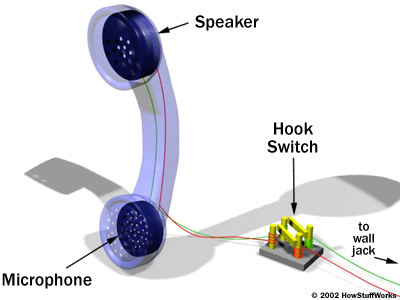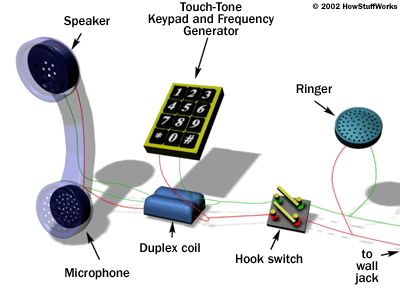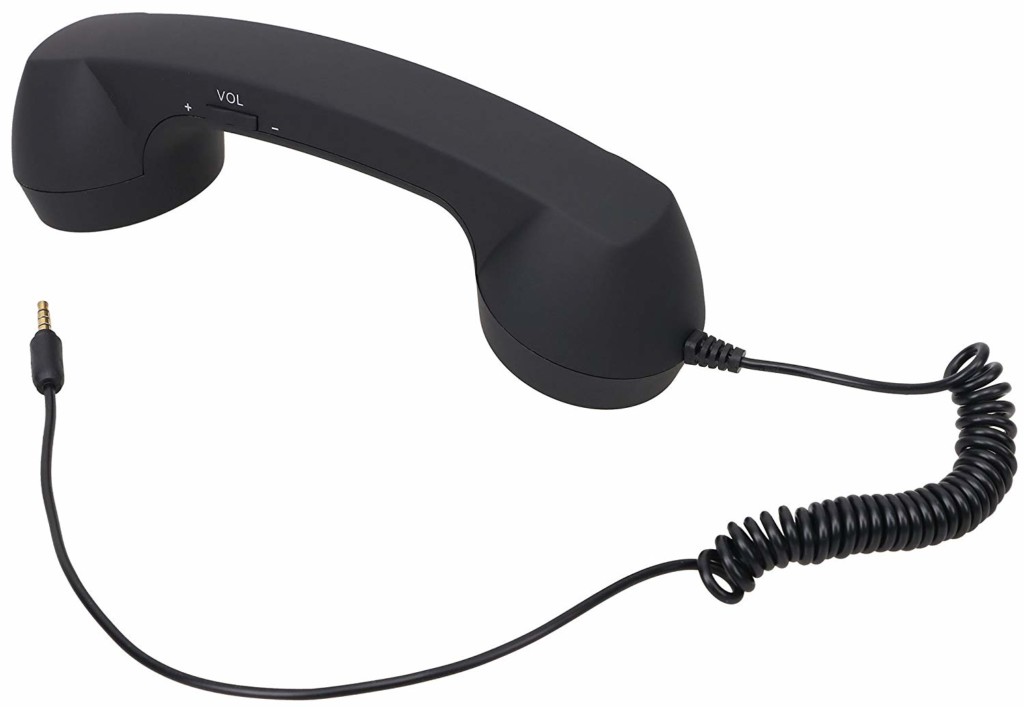The telephone (and now the cell phone) are a huge part of everyday life – both for personal and business use. But how does a phone work? And how did this form of communication grow to where it is today? Click on the following sections to learn the answers.
- Cell Phones vs Landlines: A Comparison
- How Does a Landline Work?
- What Does the Transmitter Do?
- What Does the Receiver Do?
- How Does a Cell Phone Work?
Although you don’t need to know exactly how a phone works in order to use one, it’s always a good idea to have a better understanding of the technology you use in your day-to-day life! To learn more about how phones work, continue reading.
Or if you’re ready to integrate the latest telecommunications technology into your business, trust the telecommunications experts at Network Telecom today! We are experts in our field and we can help your business excel.
How Does a Phone Work?
1. Cell Phones vs Landlines: A Comparison

Discover the difference between cell phones and landlines.
Both cell phones and landlines are a part of the business world. See the chart below to see a brief overview of how both types of phones work, as well as the biggest pros and cons of each.
How Does a Phone Work? Cell Phones vs Landlines
| How They Work | Biggest Pros | Biggest Cons | |
|---|---|---|---|
| Cellphones | *Cellphones use radio waves and wireless technology to allow you to speak, video chat, and text. | *Can be less expensive per month
*Can perform multiple talks, such as video chat, texting, and accessing the internet. |
*Not always reliable, dropped calls are often a risk in areas with poor reception
*The potential to mix business and personal documents, calls, and messages |
| Landlines | *Landlines use wired technology to send electrical signals to and from the sender and receiver. | *Stable, reliable connection, which is ideal for busiensses
*You can often deduct a large portion (up to 100%) of your business landline expenses on taxes. |
*Monthly fees can be more expensive
*Can only perform basic communications tasks |
Both cell phones and landlines have advantages and disadvantages. To find the right business communications tools for your company, contact the telecommunications experts at Network Telecom today! We can help you select the technology that will be a great fit for you, your employees, and your business.
2. How Does a Landline Work?

Landline phones essentially work the same when they were first invented.
Did you know that landline telephones have essentially worked in the same way since they were invited by Alexander Graham Bell in 1876? Of course, the phone sitting in your office doesn’t look like the phones they used in the 1800s, but the way they actually work has not changed much.
Parts of a Phone:
Telephones, since they were first invented, have functioned using two main parts: the transmitter and the receiver – we’ll get into that in just a minute.
Phones also contain other pieces of technology. The most basic pieces include the following:
- The speaker (the part you put your ear to)
- The microphone (the part you speak into)
- A switch (the part that connects your phone to a network)
- Other pieces that you are most likely familiar with, such as the keypad (which allows you to dial numbers using various tones), the cords for the wall jack, and the ringer
In the diagrams below, you can see all that’s necessary for a phone to function in diagram 1. However, in order for phones to do what we need, like call a number of your choice and ring when someone is calling you, your phone will look a lot more like the one in diagram 2.

(1) – Source: How Stuff Works

(2) – Source: How Stuff Works
Compare the hardware behind a “simple” telephone (1) to a “real” phone (2).
The telephones you have in your office or the landline you have at home all operate essentially the same way. Though they may seem complex, they are actually fairly simple when compared to some of the other advanced technology we use every day!
Now that you know a bit more about the parts of the phone, let’s go into more detail about the two most important pieces – the transmitter and the receiver.
3. What Does the Transmitter Do?

The phone transmitter is what allows you to hear the other person when you’re using a phone.
Have you ever wondered how your boss, co-worker, or friend hears you as you speak on the phone? It’s probably not something we often think twice about – but it is still pretty amazing that we can talk to anyone around the world with this technology.
The device that allows others to hear you when you speak on the phone is called the transmitter. The transmitter contains multiple smaller pieces of technology, including the diaphragm and carbon grains. These parts work together to pick up your voice and send it to those on the other end of the phone.
How Does a Phone Work? The Transmitter Process:
The following is a detailed description of how the transmitting process works.
- As you talk, sound waves hit the diaphragm.
- The diaphragm vibrates depending on your pitch of voice.
- As the diaphragm vibrates, it puts pressure on carbon grains located within the transmitter (loud sounds create strong vibrations, which squeeze these grains tightly; soft sounds create weak vibrations, which gently squeeze the grains).
- Electricity passes through the carbon grains – the amount of electricity that goes through the grains depends on the tightness of the grains (which is determined by how loud or softly you speak, as mentioned above).
- Electricity passes through the telephone wires and reaches the person you are talking to – the electricity contains all of the information above, which allows the person on the other end to hear what you said.

Source: Bakatronics
4. What Does the Receiver Do?

How does a phone work? An electrical current runs through the receiver as the speaker on the other end talks.
The telephone receiver is most likely the image that comes to mind when you think of a traditional landline. Although you may simply think of the receiver as just a ‘speaker,’ which is partially true, it also contains technology including another diaphragm as well as magnets.
The receiver allows you to hear others while they speak through vibrations, the diaphragm, and magnets.
How the Receiver Works:
One magnet holds the diaphragm in place, while the other magnet is an electromagnet that pulls the diaphragm away depending on the strength of the electrical current passing through.
As the speaker on the other end talks, an electrical current runs through your receiver. The stronger the electrical current is, the more the electromagnet will pull away from the diaphragm, which increases the vibrations in the receiver diaphragm.
The diaphragm in the receiver acts as a speaker and allows you to hear what the person on the other end is saying.
A phone call uses both the transmitter and the receiver – you and the person you are talking to have both of these necessary pieces within your phone, which allows you to have a two-sided conversation.

Source: Amazon
When you speak, your sound waves are converted into electrical signals. These signals are carried by telephone wires and then put into the telephone receiver of the person you are talking to. So, the sounds the receiver is hearing aren’t really your voice, it’s actually a recreation of your voice through electrical signals! You can learn more about this whole process from ThoughtCo.
Note – it’s important to keep in mind that many landlines are now wireless too! Click here to learn how a cordless telephone works.
5. How Does a Cell Phone Work?

Cell phones work similarly to landlines, but use wireless technology and radio waves to communicate instead of physical cables.
Although landlines are still one of the most popular forms of business communications, more and more companies are now integrating smartphone use into their everyday work lives.
Cell Phones use More Advanced Technology than Landlines:
As telephone technology has grown over the years, we are now in the era of smartphones. In general, much of our daily communications rely on WiFi and the use of the internet. Smartphones are more than just a phone!
In a similar way to a landline, they allow two (or more) people to converse. However, they also integrate much more advanced technology that allows users to text, video call, and access the internet.
Check out the video below to learn more about how cellphones use WiFi and send messages to each other.
Both WiFi and cellular phones rely on electromagnetic radio waves to transmit data.
If you simply want to talk to someone, both landlines and cell phones can both get the job done perfectly. However, they don’t work in the same way to accomplish the same job.
Cell Phones use Electromagnetic Radio Waves:
While landlines use electrical currents to send the sound of your voice to the receiver, cell phones use wireless technology. Cell phones use only electromagnetic radio waves to send and receive the same sound that would otherwise have to travel down wires.
With the increase of all kinds of technology, whether it’s televisions, radios, phones, or any other wireless device (even small things such as a wireless doorbell), we cannot escape electromagnetic waves.
No matter where you go, they are all around us! According to Explain That Stuff, cell phone networks are the fastest-growing source of electromagnetic energy that exists.
How does a phone work? Watch this video to learn more about electromagnetic radio waves.
So, we know that a cell phone works similarly to a landline but uses wireless technology instead.
How Wireless Technology Works:
But how does your voice wirelessly get to your co-workers, friends, and family? Similarly to landlines, when you speak into your cell phone, a microphone within picks up on your voice – and all of its tone variations. It then converts these vibrations into electrical signals (just like a landline!)
Now, here is where things are a bit different from the way a landline works. Once inside the phone, the signals are picked up by a microchip.
This microchip converts the signals into strings of numbers. Then, these numbers are ‘packed up’ into a radio wave, and then released by your phone’s antenna. Once the radio wave is released, it rushes through the air until it finds a cell phone mast.
Once the mast gets the radio wave, it sends it to the ‘base station.’ Explain That Stuff describes what happens once the radio waves hit the base station:
“From the base station, the calls are routed onward to their destination. Calls made from a cell phone to another cell phone on the same network travel to their destination by being routed to the base station nearest to the destination phone, and finally to that phone itself.”
As you can see, both landlines and cell phones rely on electronic waves to send and receive signals.
However, the way that these electronic waves are sent and processed varies between wireless and wired connections.
Trust Network Telecom To Help You Find The Best Telephone System For Your Company

Update your business phone system with Network Telecom’s help.
Has all this talk about telephones got you thinking about updating your business phone system? If you need to update your current telecommunications system, partner with Network Telecom.
We will help you choose a phone system that is perfect for your business. Whether you are looking to have a new phone system installed or your current system updated, you can trust Network Telecom to offer you the expert advice you require.
Network Telecom can also help you with video conferencing solutions that will meet your business’s particular needs. In addition, if your phone system is not working as it should, our trained technicians are available to help 24 hours a day, 7 days a week, 365 days a year.
We carry a huge selection of parts in order to quickly solve any components issue you are experiencing. If you are having a telecommunication or networking issue, we can resolve it quickly and professionally.
Network Telecom assisted us in moving and upgrading our system when we moved into a new facility. They have been with us while we grew and made additional changes. They are there for us when needed and have provided us with our equipment and program changes. They are a great group to work with.
In addition to our accredited and certified technical expertise, we offer:
- Consultative Sales
- Cloud Services
- Ongoing Support
- Voice Mail Systems
- System Design + Consulting
- System Admin + User Training
- PA Systems
- VoIP Specialist
- Network Cabling
Contact us today for all of your telecommunication questions and concerns; we’d be happy to help you.



